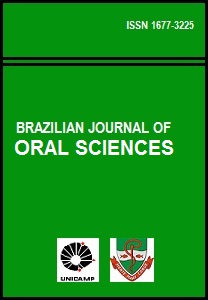Abstract
The aim of this study was to evaluate the influence of powder/liquid ratio in the diametral tensile strength of two resin-modified glass ionomers cements (RMGIC). Two Brazilian brands of RMGIC: Resiglass R (RG: Biodinâmica) and Vitro Fil LC (VF: DFL) were used. Each product was mixed in two different powder/liquid ratios, (1:1) 1 scoop of powder to one drop of liquid or (1:2) 1 scoop of powder to 2 drops of liquid. The control was considered the powder/ liquid ratio recommended by each manufacturer (RG 1:1 and VF 1:2 P/L). Four groups (n=5) with sample dimensions of 2.5 and 5.0 mm (thickness and diameter respectively) were tested. Diametral Tensile Test was performed in a mechanical testing machine (EMIC DL 500). Data obtained were submitted to One-way ANOVA and Tukey’s multiple comparisons test (α=5%). For both national RMGICs, the experimental variations in the powder/liquid ratio led to an increase in diametral tensile strength when compared to the ratios advocated by the manufacturers. Group VL manipulated with experimental ratio 1:1 showed statistically the highest (25.54±2.38 MPa) DTS mean among the tested groups whereas Resinglass R manipulated with 1:1 ratio, as advocated by manufacturer, showed statistically the lowest DTS mean (9.27±1.37 MPa). A review and further adjustments in the ratios recommended by the manufacturers of both resin-modified glass ionomers cements investigated is necessaryReferences
Fleming GJP, Farooq AA, Barralet JE. Influence of powder/liquid mixing ratio on the performance of a restorative glass-ionomer dental cement. Biomaterials. 2003; 24: 4173-9.
Mitsuhashi A, Hanaoka K, Teranaka T. Fracture toughness of resin-modified glass ionomer restorative materials: effect of powder/liquid ratio and powder particle size reduction on fracture toughness. Dent Mater. 2003; 19: 747-57.
Wilder AD, Boghosian AA, Bayne SC, Heymann HO, Sturdevant JR, Roberson TM. Effect of powder/liquid ratio on the clinical and laboratory performance of resin-modified glass ionomers. J Dent. 1998; 26: 369-77.
Young AM, Rafeeka SA, Howlett JA. FTIR investigation of monomer polymerisation and polyacid neutralisation kinetics and mechanisms in various aesthetic dental restorative materials. Biomaterials. 2004; 25: 823-33.
Bresciani E, Barata TJE, Fagundes TC, Adachi A, Terrin MM, Navarro MFL. Compressive and diametral tensile strength of glass ionomer cements. J Appl Oral Sci. 2004; 12: 344-8.
Cefaly DFG, Franco EB, Mondelli RFL, Francisconi PAS, Navarro MFL. Diametral tensile strength and water sorption of glassionomer cements used in atraumatic restorative treatment. J Appl Oral Sci. 2003; 11: 96-101.
Anusavice K J. Phillips’ science of dental materials. 11. ed. Philadelphia: WB Saunders; 2003.
The Brazilian Journal of Oral Sciences uses the Creative Commons license (CC), thus preserving the integrity of the articles in an open access environment.

